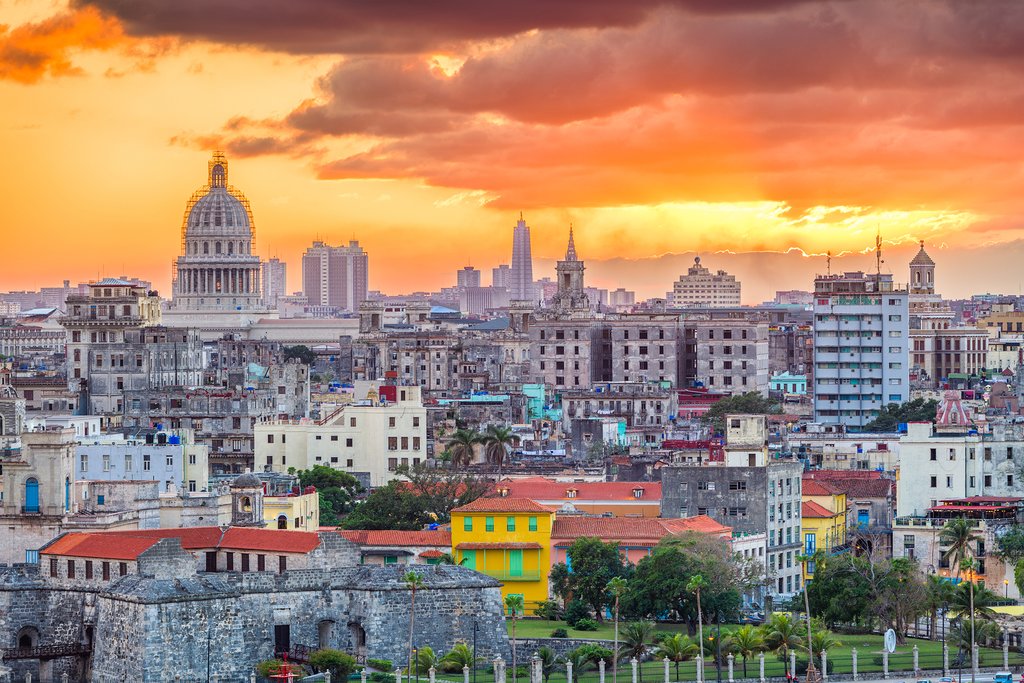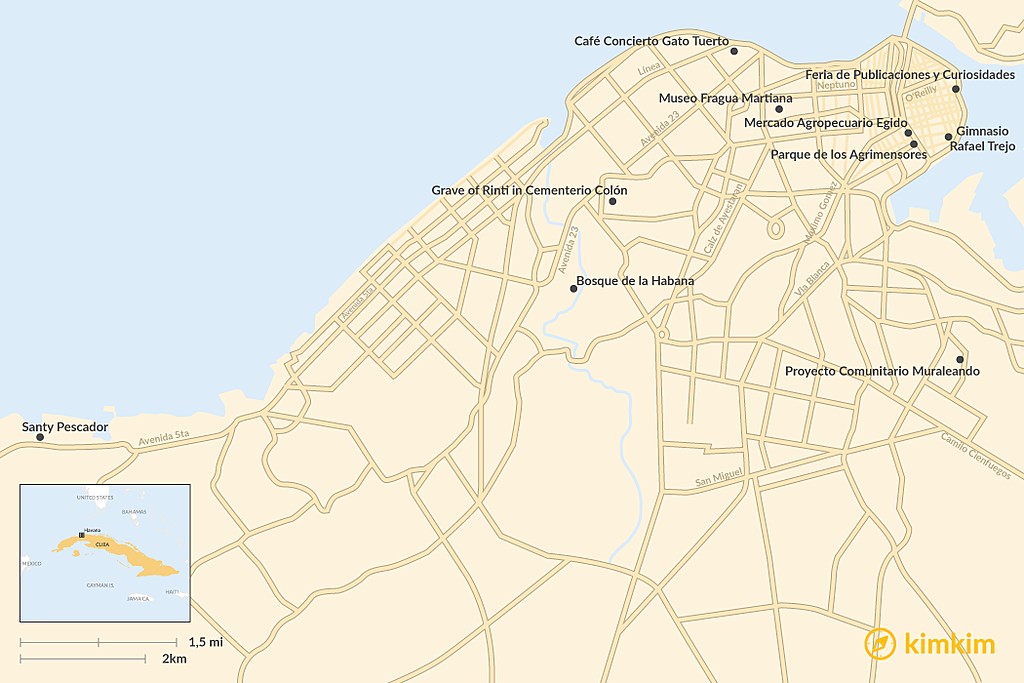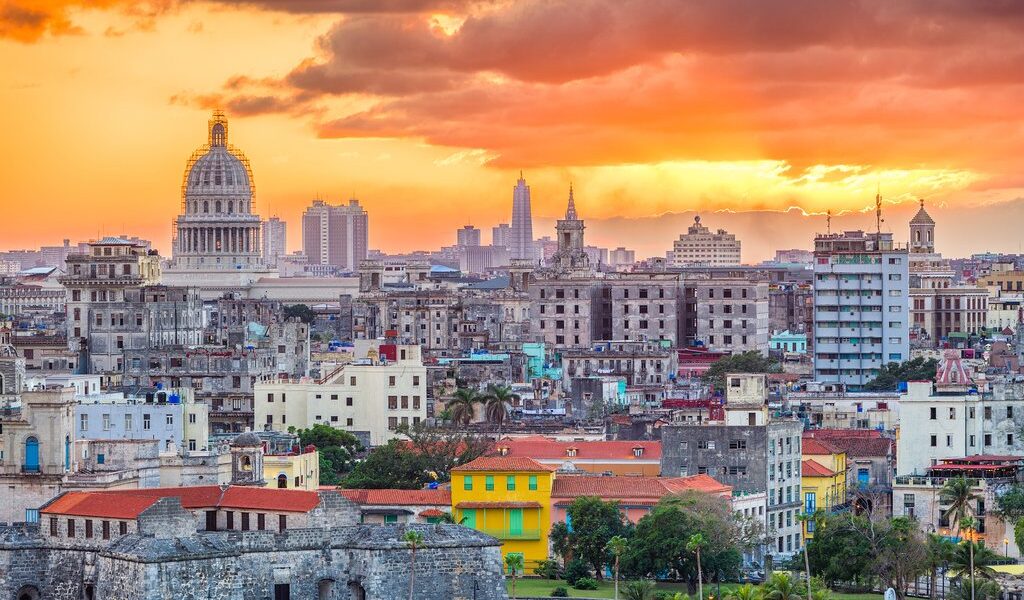
Havana is Cuba’s capital city and the island’s largest and most diverse metropolis. Here it’s easy to find little-visited colonial quarters and fascinating points of interest, many well off the tourist path. Havana’s cultural scene is vibrant, and new dining and nightlife venues continue to pop up—due in no small measure to the communist government’s liberal reforms. The following 10 places are well worth seeking out to escape the masses.
## Discovering the Hidden Gems of Havana: A Journey Beyond the Tourist Trail
Havana, a city brimming with vibrant culture, captivating history, and undeniable charm, offers far more than just the well-trodden tourist paths. Venture beyond the iconic landmarks and delve into the heart of this captivating metropolis to uncover its hidden treasures. From historical parks showcasing vintage locomotives to community art projects breathing life into overlooked neighborhoods, Havana promises an unforgettable adventure for the discerning traveler. Join us as we explore ten remarkable destinations that reveal the authentic spirit and soul of this extraordinary city.
### #1 Parque de los Agrimensores (Park of the Surveyors): A Nostalgic Journey Through Time
For those with a penchant for the romance of railways and the allure of bygone eras, the leafy embrace of Parque de los Agrimensores (Park of the Surveyors) offers an unparalleled experience. This unique park is a haven for train enthusiasts, showcasing a remarkable collection of more than a dozen antique steam trains, each a testament to a rich industrial past. These majestic old engines, now silent sentinels of a different age, were once the workhorses of the Cuban sugar industry, diligently hauling sugarcane across the island’s vast plantations. After decades of dedicated service, they were retired to this park, offering visitors a chance to step back in time and marvel at their engineering prowess.
The majority of these magnificent machines were crafted by the renowned Baldwin Locomotive Works in Philadelphia, dating back to the roaring twenties. However, the eclectic assortment boasts an even older treasure – a genuine relic from 1878! Imagine the stories etched into its iron frame, the journeys it undertook, and the history it witnessed. The park itself is conveniently located on the north side of the Estación de Ferrocarrilles Central, Havana’s bustling main railway station, making it easily accessible for those eager to embark on this nostalgic journey. Step into a world where steam reigned supreme, and discover the captivating history of Cuba’s railway heritage at Parque de los Agrimensores.
*Avenida Egido at Calle Arsenal, Habana Vieja*
### #2 Proyecto Comunitario Muraleando (Community Muraling Project): Art Reclaiming the Streets
Havana is a city known for its vibrant community spirit, and numerous projects reflect the dedication of its residents to improving their surroundings. However, the Proyecto Comunitario Muraleando (Community Muraling Project), nestled within the Diez de Octubre district, stands out as a shining example of creativity and resilience. Born from the frustration of local residents who were tired of seeing their streets plagued by accumulating trash, this inspiring initiative began in 2001. In a remarkable act of resourcefulness, they decided to transform their problem into an opportunity, collecting recyclable garbage and breathing new life into it by transforming it into art.
The results are nothing short of breathtaking. More than four blocks along Calle Aguilera, and extending into the adjoining streets, have been transformed into a vibrant open-air gallery. Colorful murals adorn the walls, depicting scenes of daily life, celebrating Cuban culture, and expressing the hopes and dreams of the community. Imaginative art pieces, crafted from recycled materials, add a whimsical touch, such as the iconic Arco de Triunfo, an arch ingeniously constructed from old car wheels and rims. The project also includes a heartfelt homage to the Virgen de la Caridad del Cobre, Cuba’s patron saint. Keep an eye out for the former derelict water tank, now beautifully repurposed as the community headquarters. This space not only serves as an administrative center but also doubles as a dynamic art space and performance center. On weekends, the space buzzes with activity as local children participate in free art lessons, nurturing their creative talents and fostering a sense of community pride. Before you leave, be sure to browse the diverse array of artwork on display, including fantastic paintings, sculptures, and jewelry items, and support the project by purchasing a unique souvenir.
*Calle Aguilera, corner of Rafael de Cárdenas, Luyanó*
### #3 Feria de Publicaciones y Curiosidades (Publications and Curiosities Market): A Treasure Trove of Literary and Historical Relics
For decades, Havana’s iconic Plaza de Armas was synonymous with a vibrant second-hand book and flea market, a beloved fixture in the city’s cultural landscape. However, in 2017, this cherished institution underwent a subtle relocation, moving a mere 50 meters away. Now known as the Feria de Publicaciones y Curiosidades (Publications & Curiosities Market), it is tucked away in a charming, out-of-the-way courtyard just off Calle Barratillo, to the southeast of the main square.
This hidden gem is a treasure trove for collectors, history buffs, and anyone with a passion for the unique and unusual. Here, dozens of stall-keepers offer a tantalizing array of sundry items, each with its own story to tell. From tattered books bearing the marks of time to rare revolutionary-era posters that capture the spirit of a nation in transformation, the market is a feast for the eyes and the imagination. Delve deeper and you might uncover antiquarian postage stamps, offering a glimpse into Cuba’s postal history, or other fascinating bric-a-brac that whispers tales of the past. Be sure to keep an eye out for the Album de la Revolución Cubana—an album of revolutionary collector’s cards, similar to baseball cards, offering a fascinating snapshot of the key figures and events of the Cuban Revolution. This unique and informative keepsake makes a great souvenir.
*Calle Barratillo, between Obispo and Justíz, Habana Vieja*
### #4 Mercado Agropecuario Egido (Egido Farmer’s Market): A Sensory Explosion of Cuban Flavors and Culture
Havana boasts a multitude of *mercados agropecuarios* (farmers markets), each offering a glimpse into the city’s vibrant culinary scene. While the granddaddy of all markets, the Cuatro Caminos, has unfortunately closed its doors, the farmers market off Egido (Avenida Bélgica) now reigns supreme as the largest and most colorful. This bustling marketplace is a true sensory explosion, divided into distinct sections dedicated to meats, vegetables, flowers, and even livestock.
More than just a place to buy groceries, the Mercado Agropecuario Egido is a vibrant hub of Cuban culture, offering a fascinating glimpse into the daily lives of the city’s residents. Here, you’ll witness captivating street theater unfold before your eyes. Pig’s heads dangle from hooks, tottering old women carry live chickens around by their feet, and even Carmen Miranda lookalikes sell vibrant bouquets of flowers. Be sure to bring your camera to capture the vibrant scenes and colorful characters, but remember to guard your valuables, as this dense hub of activity can be a pickpocket’s paradise. The market provides an authentic and unforgettable experience, immersing you in the sights, sounds, and smells of Cuban life.
*Avenida Bélgica, corner of Corrales, Habana Vieja.*
### #5 Gimnasio Rafael Trejo (Rafael Trejo Boxing Gym): Witnessing the Legacy of Cuban Boxing Glory
Did you know that Cuba was once a global powerhouse in the world of boxing? It’s a remarkable fact that this relatively small island consistently outperformed heavyweight nations like the USA in terms of Olympic medals and world championships. Boxing is not merely a sport in Cuba, it’s a deeply ingrained part of the nation’s culture and identity. To truly appreciate this rich sporting heritage, take a stroll through the tumbledown streets of southern Habana Vieja and seek out the Gimnasio Rafael Trejo. This legendary boxing gym is steeped in history, having been the training ground for 32 Olympic gold medal winners.
The dilapidated open-air ring, housed within a building whose facade long ago succumbed to the elements, is a testament to the dedication and resilience of Cuban boxers. Witnessing lionhearted young boxers, including women, train within its hallowed halls is a truly inspiring experience. It reinforces Cuba’s storied ability to punch above its weight, overcoming adversity to achieve greatness on the world stage. The Gimnasio Rafael Trejo is not just a gym, it’s a symbol of Cuban pride, determination, and the enduring spirit of a nation.
*Calle Cuba 815, between Merced & Leonor Pérez, Habana Vieja.*
### #6 Museo Fragua Martiana (José Martí Memorial/Museum): Honoring a National Hero
José Martí, Cuba’s revered National Hero, endured a period of hard labor at this site in Centro Habana, breaking rocks in a limestone quarry after being convicted of treason at the young age of 17. Today, this quarry has been transformed into a hallowed ground, lovingly preserved as a landscaped garden and a small museum dedicated to Martí’s life and legacy. The museum’s exhibits include Martí’s revolver, a poignant reminder of his involvement in the struggle for Cuban independence, as well as various monuments honoring Martí and the enslaved people who toiled alongside him under harsh conditions.
The Museo Fragua Martiana is particularly significant on January 27, especially at night, when thousands of torch-carrying students march from the nearby Universidad de la Habana to the former San Lázaro quarry. The Marcha de las Antorchas (March of the Torches) commemorates the event that took place on January 27, 1953, when students led by Havana University alum and revolutionary leader Fidel Castro gathered at the Fragua Martiana to celebrate José Martí’s birth and demonstrate against Batista’s coup d’état. The Museo Fragua Martiana is more than just a museum, it’s a powerful symbol of Cuban patriotism, resilience, and the enduring legacy of José Martí.
*Calle Principe 108, corner of Hospitál, Centro Habana*
### #7 Grave of Rinti in Cementerio Colón: A Tale of Unwavering Loyalty
Cementerio Colón, Havana’s remarkable necropolis, is a must-see destination for visitors to the city. However, most tourists tend to focus solely on the main boulevard, Avenida Cristobal Colón, where the most opulent and eye-catching tombs are located. But the sprawling cemetery encompasses nearly 60 city blocks, concealing countless hidden gems of Carrara marble that remain unseen by the majority of visitors.
After exploring the main avenue and paying your respects at La Milagrosa (the most popular grave), venture west along Calle Fray Jacinto to discover the touching story of Jeannette Ford Ryder (Calle 14 between H & Fray Jacinto), an American animal lover depicted in repose with a dog at her feet. The dog is her ever-faithful Rinti, who, after Ryder was buried in 1944, sniffed out her tomb and refused to eat, drink, or leave until he, too, died and was interred alongside her. This moving testament to the unwavering loyalty of a canine companion is a truly unforgettable sight. Nearby, at Calle 6 & G, lies the grave of Juana Martín de Martín, topped by a large, black-and-white, double-three domino block. This old tiles fanatic apparently died during a game after throwing a fit at not being able to play her precious piece, thus losing both the game of life and dominoes at the same time. These hidden stories within Cementerio Colón offer a deeper understanding of Havana’s history and the lives of those who have shaped it.
*Avenida Zapata at Calle 12, Vedado*
### #8 Café Concierto Gato Tuerto (Gato Tuerto Nightclub): An Intimate Night of Cuban Music and Dance
This intimate nightclub, nestled in the heart of Vedado, has been a Havana institution since the 1950s. While the original bar has been replaced and the interior layout has undergone some changes, losing some of its original ’50s Rat Pack swankiness, the Café Concierto Gato Tuerto continues to draw crowds night after night. Cubans, along with a scattering of expats and savvy tourists, flock to this legendary venue for one reason: the raucous music.
Every night features a dynamic medley of genres, from romantic *bolero* and traditional *trova* to soulful *música filin* and even contemporary rap. The dance floor may be small, but don’t let that deter you from joining the throng of Cubans who need little encouragement to leap up from their tables and dance. Immerse yourself in the infectious rhythm, let the music move your feet, and experience the vibrant energy of Havana’s nightlife at its finest. The Café Concierto Gato Tuerto offers an authentic and unforgettable taste of Cuban musical culture.
*Calle O 14 between 17 & 19, Vedado*
### #9 Santy Pescador: A Culinary Oasis on the Outskirts of Havana
Sometimes, you crave something different from the ubiquitous rice, black beans, and roast chicken that form the staple of Cuban cuisine. When that craving strikes, and you yearn for, say, sushi, then flag down a cab or hop in an *almendrón* (shared taxi) and head to Jaimanitas, a charming neighborhood on the western outskirts of town. Ask around for Santy’s, a unique bi-level wooden shack-turned-restaurant tucked away on the riverside amid funky wharves and even funkier fishing boats.
This private restaurant, run by a local fishing family, serves delectable sashimi and sushi, alongside more traditional seafood dishes. The freshness of the ingredients is unparalleled, sourced directly from the ocean by the family’s own fishing boats. And yes, you can even purchase saki to complement your meal. Santy Pescador is a culinary oasis, offering a delightful respite from the usual Cuban fare and a chance to experience the laid-back charm of Jaimanitas.
*Calle 240A 3 between C & Río, Jaimanitas*
### #10 Bosque de la Habana (Havana Forest): A Mystical Escape from the City
Reminiscent of a setting from *Lord of the Rings*, the otherworldly Bosque de la Habana (Havana Forest) offers a stark contrast to the urban landscape of the city. This eerie forest, with its vine-draped *jagüey* trees, lines the west bank of the Río Almendares and stretches one kilometer along the road connecting Nuevo Vedado and the Kohly districts. The lovely bridge at its southern end is a popular spot for *quinceañera* photo shoots, capturing the magic of this enchanting location.
Look closely at the base of the *jagüeys* and you may discover macabre dolls and tiny offerings to the *orishas* (saint-like gods) of the Afro-Cuban *santería* religion, adding to the forest’s mystical atmosphere. While the Bosque de la Habana is a beautiful and serene escape, it’s best not to walk solo, as robberies have been reported. Explore this hidden gem with a friend or as part of a guided tour to fully appreciate its unique beauty and cultural significance. The Bosque de la Habana provides a unique opportunity to connect with nature and experience the spiritual side of Cuban culture.
*Calle 49C between Avenida Zoológico (Nuevo Vedado) and Avenida 23 (Kohly)*
These ten destinations offer just a glimpse into the hidden treasures that Havana has to offer. By venturing beyond the well-trodden tourist trails, you can discover the authentic spirit and soul of this captivating city, creating memories that will last a lifetime. So, pack your bags, embrace the unknown, and prepare to be enchanted by the magic of Havana.

B-671

